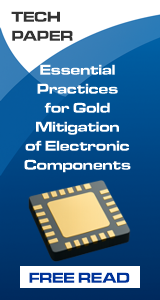|

|
Inline Assembly of Flex PET Circuits
Production Floor |
|
Authored By:Ara Parsekian, Ph.D., Harry Chou, Ph.D., Ian Rawson, John Ukwuoma, Vahid Akhavan, Ph.D. PulseForge, Inc. TX, USA SummaryPolyethylene terephthalate (PET) is a desirable substrate for flex PCBs on the basis of its low cost, biocompatibility, optical transparency, ease of processing, and recyclability. These advantages are particularly consistent with industry trends toward electronic products seamlessly incorporated into everyday items. While PET is largely incompatible with conventional reflow processes, photonic soldering is capable of overcoming the challenges of such a low-temperature material. Photonic soldering is a rapidly emerging approach that relies on high-intensity broad spectrum light, rather than thermal convection, to heat solder and electronic components selectively without damaging the optically clear substrate. In this work, we demonstrate photonic reflow of SAC305 solder alloy to assemble 0201 LED components on PET-core flex PCBs, using a SMEMA-compliant inline tool. Energy savings and throughput advantages inherent to photonic tools are illustrated, with specific focus on the quality and consistency of the resulting solder joints. Functional integrity of the solder joints is verified after accelerated thermal aging, and repeatability is characterized in terms of process yield. X-ray microscopy and SEM cross-section imaging of the resulting solder joints exhibit robust intermetallic regions and low void density. These results indicate photonic soldering as a practical manufacturing pathway to the product design possibilities that PET flex can uniquely offer. ConclusionsThe emergence of a manufacturing pathway for flex PCBs that does not require high-temperature PI substrate represents significant value to flexible electronics where cost, optical performance, and mechanical strength are paramount. This work has demonstrated the assembly of standard components on thermally sensitive PET flex material using conventional solder pastes in an inline process. Electrical connectivity, solder joint morphology, process yield, and accelerated lifetime test results are on par with expectations for components on comparable circuits regardless of the reflow technique. Ascertaining a more precise upper limit of process yield for photonic soldering is likely possible, with improvements to the component placement step and a larger sample size of test circuits. Such an extension of the present study is left to future work. These results demonstrate a new option for flex PCB material selection in a context where other perceived benefits of photonic soldering – namely, high throughput, small process footprint, and non-contact heating – also confer. Within this study, reflow represents the shortest process in the assembly line, in contrast to the conventional approach, where a convection oven constitutes the rate-limiting assembly step. Notably, the 20 s reflow cycle time in this study is a function of total board length, and independent of component density. In future work, it will likely be worthwhile to continue cross-examining the expected benefits of photonic soldering under other representative scenarios. Chip components with significantly smaller footprints, for example, are of particular interest for photonic soldering due to its capability for non-contact heating without active airflow. The high degree of digital control over process duration and radiant power is also highly relevant to the metallurgic structure of joints, and future studies aimed at purposeful management of IMC formation are likely to yield significant insights. Additionally, the inquiry of this study can easily be expanded to other polymer substrates that provide additional functionality – for example, pressure or chemical sensitive polymers for sensors, and biologically active polymers for MEMS applications. The present study provides a strong indication that continued investigations of photonic soldering will enable the construction of flex PCBs with novel materials, in ways that will become commercially relevant and impactful. Initially Published in the SMTA Proceedings |
|
Comments
|
|
|
|

|


